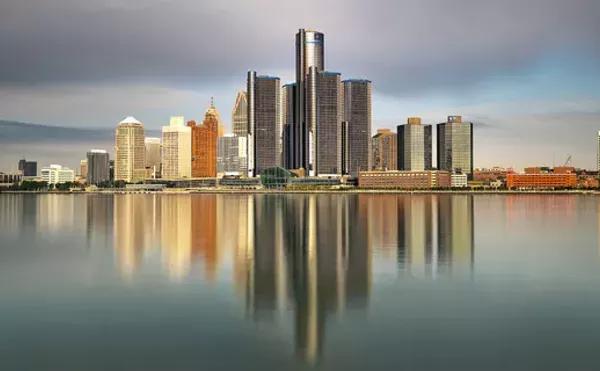Long-rumored International Bridge finally appears to be gaining traction in Delray
Under the bridge?

Audio By Carbonatix
[
{
"name": "GPT - Leaderboard - Inline - Content",
"component": "35519556",
"insertPoint": "5th",
"startingPoint": "3",
"requiredCountToDisplay": "3",
"maxInsertions": 100,
"adList": [
{
"adPreset": "LeaderboardInline"
}
]
}
]
Talk of a new bridge between Windsor and Detroit has dragged on so long that it might as well be an urban legend to folks in Delray, the down-on-its-luck Southwest Detroit neighborhood where the project will touch down. After 10 years of speculation, though, the effort to build the long-rumored New International Trade Crossing (NITC) finally appears to be gaining traction.
Michigan and the Windsor Detroit Bridge Authority, the Canadian entity that will oversee the project on a daily basis, are currently engaged in pre-construction activities to set the stage for retaining a concessionaire to begin work on the span, according to MDOT. To this end, the state is pushing a $1.42 million Michigan Land Bank deal to purchase 301 tax-reverted properties in the prospective U.S. project footprint from the city. Voluntary purchases from individual property owners and businesses are slated for next year. Michigan officials are also working to hash out a development agreement with city leadership that includes language on community benefits for Delray and Southwest Detroit. Construction is expected to start in 2016 and wrap up by 2020.
The $2 billion-plus project promises to ease traffic congestion and boost regional trade by linking I-75 with Canada's Highway 401 and providing an alternative to the Ambassador Bridge.
MDOT Communications Director Jeff Cranson said via email that construction will create thousands of Michigan jobs and that he expects the crossing to spur economic growth and job creation that directly benefits Delray and Southwest Detroit.
"It is expected that the NITC project, as well as other unique resources and infrastructure in Michigan will catalyze the creation of one or more transportation, distribution and logistics hubs that will spur long-term economic growth and job creation in economically disadvantaged Detroit," Cranson tells Metro Times.
Despite these projections, recent momentum has raised concerns. Many Detroiters fear the city is getting a raw deal from Michigan and Canada. The impact on Delray, which will be hosting the bridge, an I-75 interchange and a 170-acre customs plaza, has been a particular flashpoint. Construction will take a sizeable chunk out of the neighborhood and could impact access to a community health clinic. Mitigating truck traffic and emissions is also a pressing matter for residents.
"I'm concerned about the state of the neighborhood, the impact, the pollution," says Scott Brines, president of the Southwest Detroit Community Benefits Coalition (SDCBC), the driving force for neighborhood benefits. "We want to be [seen] in a different light that shows, 'Hey, this is the United States of America. Welcome to Michigan. We are the new face of Michigan.'"
The Streets of Delray
Butting up against the Detroit and Rouge rivers on Detroit's southwest side, Delray certainly has its share of troubles.
According to Data Driven Detroit, 38 percent of households in Council District 6, where Delray sits, live in poverty. Since the district also contains more affluent neighborhoods, the reality there is, if anything, bleaker than that.
Delray's proximity to industrial sites like Zug Island has piled environmental problems onto economic ones. A University of Michigan analysis using 2006 EPA Toxic Release Inventory data ranked its ZIP code, 48209, the seventh most toxic in Michigan.
Michael Christopher, a 58-year-old building trades worker, has lived in Delray his whole life and owns property near the footprint. He describes the neighborhood's plight more tangibly.
"Some of the alleyways are overrun with trees," he says. "It looks like a jungle. You have constant sewage clogging because the city never comes to maintain, and then you have a lot of dumping. The police hardly ever patrol. It's an area where we're left to defend ourselves."
Growing up, Christopher experienced a different Delray, with beautiful houses, orderly alleyways, magnificent trees, and bustling streets filled with bakeries, shoe shops, and ice cream parlors.
He attributes the decline to manufacturing loss, political corruption, scrapping, and lax pollution controls. As a member of SDCBC, Christopher has attended countless protests and hearings for community benefits. Through it all, he's maintained a glimmer of optimism.
"I look at the bridge as bringing new hope for prosperity to an area like Delray," he says. "The entire Southeast Michigan community can prosper, if it's done right."
Unfortunately, he's not convinced that Canada and the state of Michigan will do right by Delray.
Land and Benefits
Christopher isn't alone. Residents and supporters flocked to City Council's recent NITC hearings. Some demanded community benefits. Others even picketed the land deal.
Despite the $1.42 million land transfer being vetted by the city assessor, it raised eyebrows at the Sept. 8 council hearing. Council Member Gabe Leland referred to the deal as a "fire sale," adding, "When we look at what property is worth in this town, it doesn't add up." What's more, state officials couldn't guarantee proceeds wouldn't go to creditors in the city's ongoing bankruptcy.
The proposed Neighborhood Development Agreement (NDA) met with similar skepticism. A draft obtained by Metro Times includes numerous references to community benefits, including measures to help mitigate the impact of truck traffic, noise, and emissions; an employment service center; promoting the hiring of qualified locals for NITC jobs; quality of life enhancements like blight removal and park beautification; and a feasibility study on how to develop Fort Wayne.
The sticking point is that benefit funding would need to come from existing city and state sources or Canada, which is footing the NITC bill.
To ensure benefits from Canadians, Detroit needs to work through an entity called the International Authority, which will oversee the P3 (Public-Private Partnership) procurement process for the project and monitor the Windsor-Detroit Bridge Authority's compliance with a Crossing Agreement signed between the state and Canada.The IA consists of three Canadian and three Michigan appointees—none from the city. Under the NDA, the city would get representation from a consultative body called the Community Advisory Group.
As a result of land deal doubts, weak benefits guarantees, and zero Detroit representation on the International Authority, City Council unanimously rejected the NITC measures on Sept. 9. Emergency manager aide Gary Brown had informed them his boss planned to approve the transfer anyway, potentially without benefits. Council now has an opportunity to present a counterproposal to a state emergency loan board, according to the Detroit Free Press.
Exasperated by the situation, SDCBC President Brines shared his thoughts prior to Council's vote.
"There's a lot of mention of community benefits, but there's no guarantees," he said. "There's always a handshake. They're not legally binding."
Still, he pledges to stick it out for the best outcome possible.
"We've created too many authorities, too many advisories," he says. "Let's really try to make this partnership work between the city, the state, between Canada and the concessionaire, and make this a world-class crossing." — mt
David Sands is a Detroit-based freelance writer. He has covered transportation news as a staff writer for Mode Shift.





